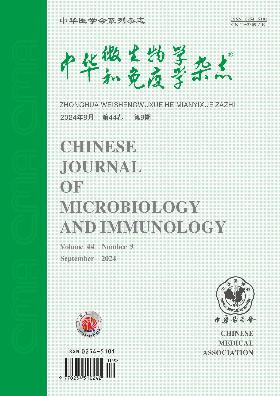云南省2018年6个地市手足口病病例病原学分析及柯萨奇病毒A6基因特征
Q4 Immunology and Microbiology
引用次数: 0
摘要
目的检测2018年云南省6个地市510份手足口病(HFMD)粪便标本中肠道病毒VP4和VP1基因,分析柯萨奇病毒A6(CV-A6)毒株VP1全基因系统发育特征。方法从粪便中提取病毒核糖核酸。通过RT-PCR扩增VP4基因序列,并使用MD91/OL68-1引物对进行测序以鉴定病毒基因型。使用合适的引物对扩增并测序整个VP1基因序列。CV-A6参考菌株的VP1基因全序列从GenBank下载。利用MEGA5.2软件分析不同菌株核苷酸和氨基酸序列的相似性,构建系统发育树进行遗传特征和分子流行病学分析。结果510份粪便标本中有57份获得了VP4和VP1基因序列,阳性率为11.17%(57/510)。有43株CV-A6(8.43%,43/510),6株CV-A10(1.17%,6/510),2株肠道病毒A71(EV-A71,0.39%,2/510)和2株CV-A9(0.39%,2/110)。其余4株分别为CV-A4(0.19%,1/510)、CV-A5(0.19%、1/510),CV-B1(0.19%和1/510)和E11(0.19%,1/510.)。系统发育分析表明,43株CV-A6菌株均属于D3亚型。结论在510份手足口病样本中,CV-A6菌株检出率最高,为8.43%,占所有分离株的75.44%(43/57),其次是CV-A10(1.17%,6/510)和EV-A71(0.39%,2/510)。2018年云南省爆发了一次主要由CV-A6引起的大规模手足口病疫情。此次疫情是由D3亚型的CV-A6引起的,中国以往的疫情也是如此。关键词:手足口病;病原学;柯萨奇病毒A6;VP4基因;VP1基因;遗传特征分析本文章由计算机程序翻译,如有差异,请以英文原文为准。
Etiology analysis of hand, foot and mouth disease cases and genetic characteristics of coxsackievirus A6 in six prefectures/cities of Yunnan Province in 2018
Objective
To detect the enterovirus VP4 and VP1 genes in 510 stool samples collected from hand, foot and mouth disease (HFMD) cases and analyze the phylogenetic characteristics of the entire VP1 genes of coxsackievirus A6 (CV-A6) strains in six prefectures/cities of Yunnan Province in 2018.
Methods
Viral RNA was abstracted from the stool samples. VP4 gene sequences were amplified by RT-PCR and sequenced using the MD91/OL68-1 primer pair to identify viral genotypes. Whole VP1 gene sequences were amplified and sequenced using appropriate primer pairs. The whole VP1 gene sequences of CV-A6 reference strains were downloaded from GenBank. MEGA5.2 software was used to analyze the similarity in nucleotide and amino acid sequences between different strains and phylogenetic tree was constructed for analysis of genetic characteristics and molecular epidemiology.
Results
VP4 and VP1 gene sequences were obtained from 57 out of 510 stool samples with a positive rate of 11.17% (57/510). There were 43 CV-A6 (8.43%, 43/510), six CV-A10 (1.17%, 6/510), two enterovirus A71 (EV-A71, 0.39%, 2/510) and two CV-A9 (0.39%, 2/510) strains. The other four strains were CV-A4 (0.19%, 1/510), CV-A5 (0.19%, 1/510), CV-B1 (0.19%, 1/510) and E11 (0.19%, 1/510). The phylogenetic analysis showed that all 43 CV-A6 strains belonged to sub-genotype D3.
Conclusions
In the 510 HFMD samples, CV-A6 strains were mostly detected with a detection rate of 8.43% and accounted for 75.44% (43/57) of all isolates, followed by CV-A10 (1.17%, 6/510) and EV-A71 (0.39%, 2/510). There was a large HFMD outbreak mainly caused by CV-A6 in Yunnan Province in 2018. The outbreak was caused by CV-A6 of sub-genotype D3, as was the case with pervious outbreaks in China.
Key words:
Hand, foot and mouth disease; Etiology; Coxsackievirus A6; VP4 gene; VP1 gene; Genetic characteristics analysis
求助全文
通过发布文献求助,成功后即可免费获取论文全文。
去求助
来源期刊

中华微生物学和免疫学杂志
Immunology and Microbiology-Virology
CiteScore
0.50
自引率
0.00%
发文量
6906
期刊介绍:
Chinese Journal of Microbiology and Immunology established in 1981. It is one of the series of journal sponsored by Chinese Medical Association. The aim of this journal is to spread and exchange the scientific achievements and practical experience in order to promote the development of medical microbiology and immunology. Its main contents comprise academic thesis, brief reports, reviews, summaries, news of meetings, book reviews and trends of home and abroad in this field. The distinguishing feature of the journal is to give the priority to the reports on the research of basic theory, and take account of the reports on clinical and practical skills.
 求助内容:
求助内容: 应助结果提醒方式:
应助结果提醒方式:


